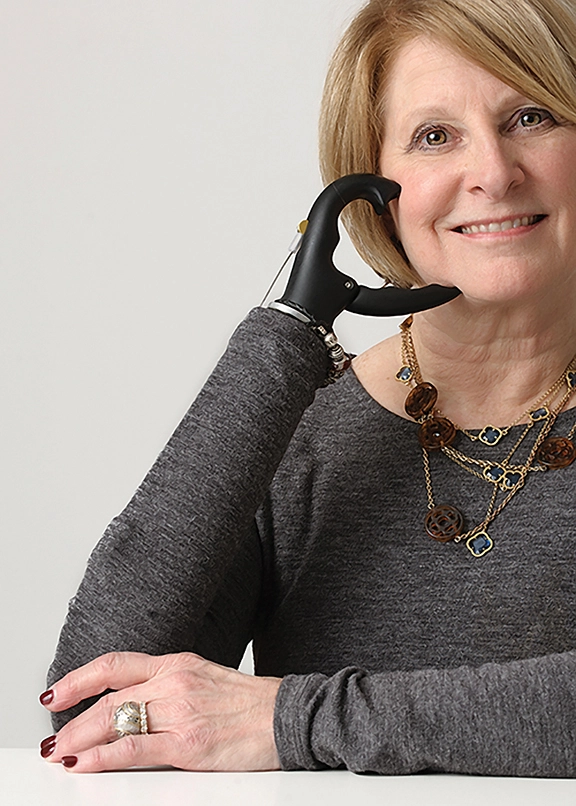By Debra Latour, Med, Advanced Practice, OTR/L

Many individuals who experience upper-limb loss, regardless of the level of loss, receive services from an occupational therapist (OT). When they first hear the term “occupational therapy,” individuals’ initial reactions are often that they are not ready to go back to work, but that misunderstanding comes from confusing the word “occupation” with “vocation.” OTs focus on the “job” of living and all that it entails. Human beings place a high value on independent function: being able to care for ourselves, our families, and our homes; and contributing to our communities through work, volunteerism, and moral behavior. All of these involve occupation as meaningful activity. OTs recognize the importance of certain treatments as beneficial to people with limb loss and utilize such interventions to facilitate functional independence, restore quality of life, promote well-being, and prevent further impairment.
OTs Focus on the “Job” of Living
This can mean many things to people who have experienced upper-limb loss. During the initial healing period, OTs utilize interventions to promote wound healing, prevent contractures or further impairment, protect available movement and abilities, provide strategies and devices to facilitate maximum independence during self-care, and work with us and our healthcare teams to prepare for prosthetic technology and plan for discharge.
Although healing, managing scar tissue, and controlling edema are the focus during the initial phase, OTs also address activities of daily living (ADLs), particularly self-care tasks. Clients may not yet have received prosthetic technology, so learning to complete personal tasks using adaptive strategies and/or assistive devices is essential. The OT can show us how to use our environment by positioning our body and objects to help us do things in ways that are less frustrating and that offer greater success. OTs can also suggest specific solutions, such as using Dycem nonslip products, using suction cups to stabilize objects, and adding Coban Self-Adherent Wrap or cylindrical tubing to items for a better gripping surface. In addition, there are many devices specifically made for one-hand use that can aid in completing tasks efficiently. These devices and strategies can be used for many other purposes, including managing our homes and properties, navigating the community, engaging in recreational activities, and returning to employment.
OTs also prepare us for prosthetic technology. Interventions may include desensitizing the residual limb to improve the ability to wear a prosthesis, therapeutic exercise to help tolerate its weight, adaptive extensions and mirror therapy to improve our perception of its length, and biofeedback and isometric exercises to improve our ability to control it. Once we receive the device, OTs help us further develop control and skill and to transfer these abilities to actual functional tasks, which may involve more adaptive strategies to improve our success.
- PROMOTE: Wound healing
- PREVENT: Further impairment
- PROTECT: Available movement and abilities
- PROVIDE: Adaptive strategies and/or assistive devices for functional independence
- PREPARE: For prosthetic technology
- PLAN: For discharge
How else can an OT help?
There are aspects of our lives that we know exist but few are comfortable addressing. I refer to these areas as “the elephants in the room.” They typically include social issues from the basic to the intimate; integrating into the community; being comfortable answering questions from people who are curious about our limb loss; learning to request, or politely refuse, assistance from well-meaning family members or others; and addressing issues related to returning to work that may include modifications to job requirements, productivity, or the environment.
OTs can help in all of these areas by integrating the community environment into the plan of care. OTs are experts in educating us and others, advocating on our behalf, and helping us advocate for ourselves. By including these elements in the plan of care as goals to achieve, quality of life may be further enhanced.
If you are thinking about returning to work, OTs can work with your employer to examine the essential functions and responsibilities of your job. Each duty can be analyzed with suggestions for how you might be able to perform the task with the use of assistive devices or adaptive strategies.
Assistive devices may be as simple as a modification to an existing tool or purchase of a device that enables you to perform the function. OTs are also able to assess the work environment for safety and efficiency to enhance your performance. In some cases, modifications to the job duties and/or productivity may be necessary. OTs can use results from functional capacity evaluations to determine these needs and help you communicate them to your case manager and employer.
While some needs, such as issues related to returning to employment, may be more obvious and less uncomfortable to address, the aspects of social function may be more challenging to identify, talk about, and pursue. We don’t want to think about how we will handle awkward, uncomfortable social situations. OTs can help us anticipate these situations and then role play so that we can determine the responses that are most natural and intuitive to us. Waiting until the actual experience to figure this out is often the worst way to handle it. Many times when we feel discomfort or are embarrassed, we act out in anger, sarcasm, or meanness and regret it, which can further diminish our self-confidence and self-esteem. Learning to have self-confidence, to feel good about our body image, and how to deal with challenging situations ahead of time can help us enjoy better overall health and quality of life.
Addressing needs related to social function, such as sexual relationships, requires communication. As stated, these topics may be difficult or delicate to discuss. Many of us do not bring them up because we are anxious or shy. Unfortunately, this may give our clinician the impression that we do not have sexual concerns that could be addressed. The American Occupational Therapy Association (AOTA) recognizes sexual intimacy as integral to the quality of life and overall psychological well-being of individuals, and sexual activity is listed as an ADL. OTs actually include sexuality as part of a patient’s initial evaluation. Amputations can cause an abundance of new challenges related to sexuality. These may include decreased mobility and difficulties changing positions, balance and stability issues, and fear of rejection, further injury, and pain. Sexuality is not just sex; it is also how we express feelings and emotions, and it represents perceptions about ourselves. While research about sexuality after amputation is limited because the topic is viewed by many as taboo, there is published evidence showing the need to facilitate discussions about sexuality in the rehabilitation process to address patients’ sexuality-based anxieties, as well as to highlight the importance of both sexual and romantic relationships to our overall quality of life.
OTs can help us in all aspects of our lives. However, to ensure successful therapy, it is important for people who have experienced upper-limb loss and their clinicians to communicate openly, honestly, and effectively. The end result can be greater functional independence; a perception of wholeness in body, mind, and spirit; and an optimal quality of life.
I would like to thank my former students, Kristina Carreira and Melissa Dexter, who bravely explored the topic of sexuality touched on in this article as their graduate thesis (Springfield College 2016).



